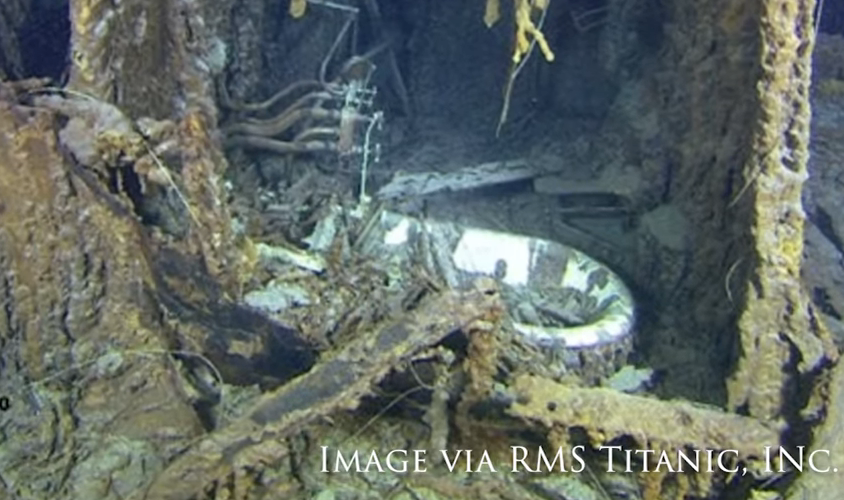Titanic’s famous captain’s bathtub reappears, as wreck’s rapid disintegration revealed in new footage
More than 100 years after it sunk, killing 1500 people, the wreck of the Titanic is deteriorating rapidly due to metal-eating bacteria
Your support helps us to tell the story
From reproductive rights to climate change to Big Tech, The Independent is on the ground when the story is developing. Whether it's investigating the financials of Elon Musk's pro-Trump PAC or producing our latest documentary, 'The A Word', which shines a light on the American women fighting for reproductive rights, we know how important it is to parse out the facts from the messaging.
At such a critical moment in US history, we need reporters on the ground. Your donation allows us to keep sending journalists to speak to both sides of the story.
The Independent is trusted by Americans across the entire political spectrum. And unlike many other quality news outlets, we choose not to lock Americans out of our reporting and analysis with paywalls. We believe quality journalism should be available to everyone, paid for by those who can afford it.
Your support makes all the difference.Footage captured from a recent expedition to the wreck of the Titanic shows the famed bathtub in the captain’s quarters thought to have been lost to decay is still intact.
But the latest survey of the shipwreck shows its disintegration continues due to salt corrosion, ocean undercurrents, and a bacteria that is steadily munching its way through the shell.
The Titanic is estimated to have less than 30 years left before it disintegrates entirely.
A team of explorers from OceanGate Expeditions conducted a series of dives to the Titanic’s wreck 3,800 metres beneath the surface of the North Atlantic Ocean this summer.
From its five-man submersible Titan, OceanGate’s cameras picked up images of the bathtub still in the ill-fated captain Edward Smith’s quarters.
“There was some scuttlebutt that the bathtub had fallen through, and it’s pretty clear it’s still there,” OceanGate CEO Stockton Rush told Geekwire, referring to media reports in 2019 that the bathtub had succumbed to decay.
“It’s just full of debris,” Mr Rush said.

The most recent OceanGate Expeditions footage does make clear that the wreck is crumbling.
Mr Rush said the decay was especially noticeable on the promenade deck of the ship.

“Looking at some of the older pictures, there are areas where you had a whole wall, and then we’d show up and there’s no wall,” Mr Rush told Geekwire.
“There’s chunks of it here, and you can see through it. So in areas where they’d actually had to enter with ROVs [remotely operated vehicles], all of a sudden the wall’s all gone.”
OceanGate Expeditions are conducting a longitudinal study of the Titanic’s rate of decay, through images, videos, laser and sonar data.
OceanGate took more than 100 customers down to the wreck over the summer at a cost of $125,000 each, and are planning yearly surveys of the wreckage.
The RMS Titanic has been lying 370 miles off the coast of Newfoundland, Canada in the North Atlantic Ocean since 1912.
In 2019, an expedition from Newcastle University in England discovered that the shell of the ship was being eaten by a bacteria that consumes metal.
During that survey, the first manned visit to the wreck in 14 years, researchers found “shocking” deterioration, and estimated the shipwreck will have disintegrated entirely within 30 years.
At the time, Titanic researcher Henrietta Mann said it was impossible to know for certain how long it would take for the wreck to disintegrate entirely.
“Logic tells you [that] more structurally it is damaged, the more quickly it will deteriorate,” Ms Mann told Time magazine.
The wreck was discovered in 1985, and was named a UNESCO cultural heritage site in 2012.
During the 2021 Titanic Survey Expedition Titan was equipped with a Rayfin SubC 4K camera, allowing our crew to capture stunning stills of the iconic wreck. Pictured here is Captain Smith's cabin. #deepdive #Titanic #submersible #history #shipwreck pic.twitter.com/4GImZw7ZLN
— OceanGate Expeditions (@OceanGateExped) September 9, 2021
More than 1500 people died in the sinking, which was dramatised in the 1997 Oscar-winning James Cameron film Titanic.
Special thanks to @SubCImaging for supplying OceanGate's Titan with the Rayfin Subsea 4k camera. The equipment has been crucial in capturing deep sea footage, most notably the Titanic bow section during the 2021 Titanic Survey Expedition, which is currently underway. pic.twitter.com/JaqrpyGFli
— OceanGate (@OceanGate) August 1, 2021




Join our commenting forum
Join thought-provoking conversations, follow other Independent readers and see their replies
Comments